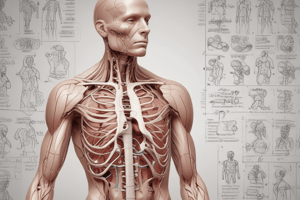Podcast
Questions and Answers
Which cranial nerve innervates the sternocleidomastoid muscle?
Which cranial nerve innervates the sternocleidomastoid muscle?
- Cranial nerve VII
- Cranial nerve XI (correct)
- Cranial nerve XII
- Cranial nerve X
Which muscle is primarily responsible for initiating abduction of the shoulder joint?
Which muscle is primarily responsible for initiating abduction of the shoulder joint?
- Supraspinatus (correct)
- Teres minor
- Infraspinatus
- Deltoid
Which artery provides the primary blood supply to the femoral head in adults?
Which artery provides the primary blood supply to the femoral head in adults?
- Superior gluteal artery
- Medial circumflex femoral artery (correct)
- Obturator artery
- Femoral artery
Which nerve is responsible for the sensory innervation of the palmar surface of the thumb?
Which nerve is responsible for the sensory innervation of the palmar surface of the thumb?
Which carpal bone is most commonly fractured?
Which carpal bone is most commonly fractured?
Which dermatome corresponds to the area of the little finger?
Which dermatome corresponds to the area of the little finger?
Which nerve is responsible for the motor innervation of the trapezius muscle?
Which nerve is responsible for the motor innervation of the trapezius muscle?
Which structure passes through the foramen ovale?
Which structure passes through the foramen ovale?
Which muscle initiates abduction of the shoulder joint beyond 15 degrees?
Which muscle initiates abduction of the shoulder joint beyond 15 degrees?
Which nerve provides sensory innervation to the palmar surface of the index finger?
Which nerve provides sensory innervation to the palmar surface of the index finger?
Which nerve passes through the foramen ovale?
Which nerve passes through the foramen ovale?
Which muscle is NOT part of the rotator cuff?
Which muscle is NOT part of the rotator cuff?
At which level of the vertebrae is the sternal angle located?
At which level of the vertebrae is the sternal angle located?
Which muscle forms the floor of the cubital fossa?
Which muscle forms the floor of the cubital fossa?
Where does the majority of lymphatic drainage from the breast go to?
Where does the majority of lymphatic drainage from the breast go to?
Which tendons border the anatomical snuffbox?
Which tendons border the anatomical snuffbox?
Which artery is a branch of the external carotid artery?
Which artery is a branch of the external carotid artery?
Which anatomical structure does the ulnar nerve pass through at the elbow?
Which anatomical structure does the ulnar nerve pass through at the elbow?
Which nerve supplies the parasympathetic fibers to the heart?
Which nerve supplies the parasympathetic fibers to the heart?
Which muscle is innervated by the deep peroneal (fibular) nerve?
Which muscle is innervated by the deep peroneal (fibular) nerve?
Flashcards are hidden until you start studying
Study Notes
Muscles and Nerves
- The trapezius and sternocleidomastoid muscles are innervated by the accessory nerve (cranial nerve XI).
- The median nerve provides sensory innervation to the palmar surface of the thumb, index, middle, and lateral half of the ring finger.
- The supraspinatus muscle is responsible for initiating the first 15 degrees of shoulder abduction.
Blood Supply
- The medial circumflex femoral artery provides the most significant blood supply to the femoral head in adults.
Fractures
- The scaphoid is the most commonly fractured carpal bone, typically due to a fall on an outstretched hand.
Dermatomes
- The C8 dermatome corresponds to the area of the little finger.
Structures and Passages
- The mandibular nerve (V3), a branch of the trigeminal nerve (cranial nerve V), passes through the foramen ovale.
- The brachialis muscle forms the floor of the cubital fossa.
- The anatomical snuffbox is bordered by the tendons of the extensor pollicis longus, extensor pollicis brevis, and abductor pollicis longus.
- The ulnar nerve passes through the cubital tunnel at the elbow.
Arteries
- The superior thyroid artery is a branch of the external carotid artery.
Heart and Nervous System
- The parasympathetic fibers to the heart are supplied by the vagus nerve (cranial nerve X).
- The tibialis anterior muscle is innervated by the deep peroneal (fibular) nerve.
Anatomy
- The sternal angle, or Angle of Louis, is at the level of the T4-T5 vertebrae.
- The central tendon of the diaphragm is derived from the septum transversum.
- The Hesselbach's triangle is bounded by the inguinal ligament, inferior epigastric vessels, and the lateral border of the rectus abdominis muscle.
- The esophagus is located in the posterior mediastinum.
Aneurysms
- The most common site for intracranial berry aneurysms is the anterior communicating artery.
Studying That Suits You
Use AI to generate personalized quizzes and flashcards to suit your learning preferences.
Description
Test your knowledge of human muscles, nerves, and blood supply with this quiz. Topics include innervation of muscles, sensory innervation, and blood supply to specific body parts.




